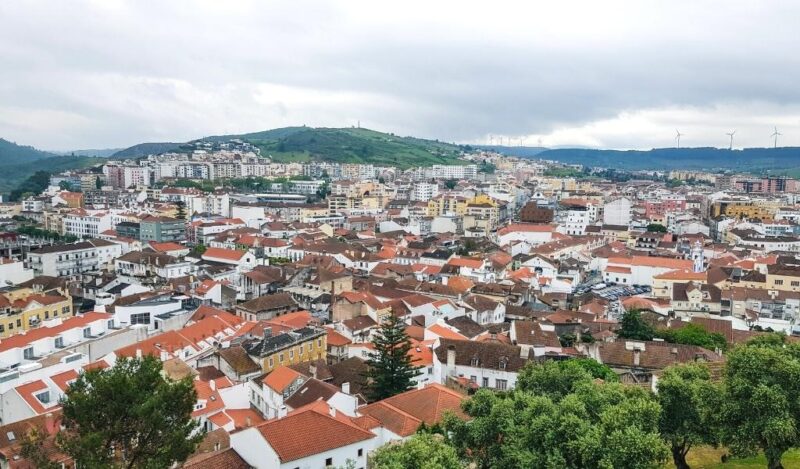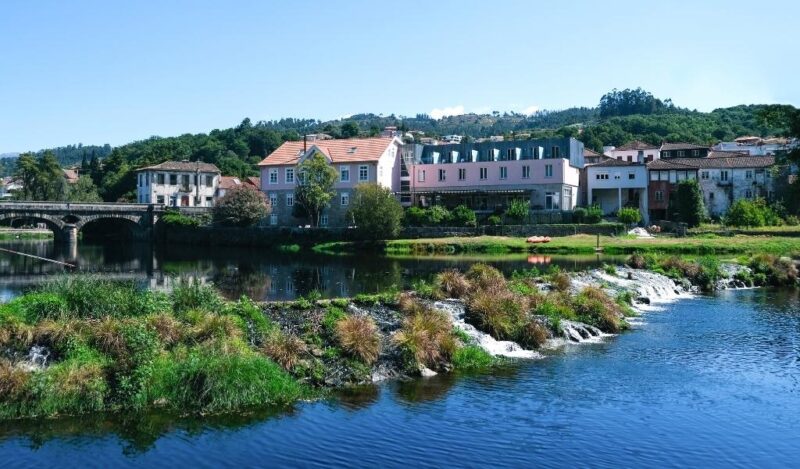Located in Idanha-a-Nova in the Castelo Branco district, the small mountain town of Monsanto is one of the “12 Historical Villages of Portugal” (a program created by the Portuguese government in 1991, to restore and enhance a series of villages in the Beira Interior region, older than the country itself).
With an imposing Templar castle, built in the 12th century and rising more than 750 meters above sea level, the historical village of Monsanto is a stunning “sea of granite”. Besides the walled enclosure of this medieval fortress, there are numerous chapels, noble manors, and houses that use this type of rock!
So, do you want to know more about 1 Day In Monsanto: The Perfect Monsanto Itinerary? Keep reading!
This post may contain affiliate links, meaning I earn a small commission if you make a purchase, at no additional cost to you. Please read my disclosure & privacy policy for more information.
No time to read now? Pin it for later!


- Brief History of Monsanto
- Visiting Monsanto
- Monsanto Itinerary
- Chapel of the Holy Spirit & Gate of the Holy Spirit (or Saint Sebastian's Gate)
- House of Fernando Namora (& Former Doctor's Office)
- Church of the Holy Savior (or Parish Church of Monsanto)
- Marquess of Graciosa Manor (or Andrade Manor)
- Lucano Tower (or Clock Tower)
- Cave
- Monsanto Castle
- Santa Maria do Castelo Chapel
- Ruins of the Settlement of the Parish of Saint Michael
- Map of the Monsanto Itinerary
- More Posts about Portugal
- More Posts about Travel Itineraries
- What Photography Gear Do I Use?
Brief History of Monsanto
According to historians, the region where the town of Monsanto is currently located has been inhabited since the Paleolithic period. In fact, the remains found in archaeological explorations show the successive presence of Lusitans, Roman, Visigothic, and Arabs, from Prehistory to the 12th century (in the heart of the Middle Ages).
It was precisely from the Moors that Afonso Henriques conquered Monsanto, in the year 1165. And as happened with many lands conquered in this period, the first king of Portugal decided to donate them to the Order of Knights Templar, as a form of gratitude for the assistance provided in combat.
Gualdim Pais (the 6th Grand Master of the Order in Portugal and the founder of cities such as Pombal and Tomar, and castles such as Almourol and Idanha-a-Nova) was responsible for the construction of the Castle of Monsanto – a work that would become requalified by King Sancho I a few decades later.

In the following centuries, the medieval fortress continued to be strengthened, while the town developed outside the walls, at the foot of the hill. Faced with this growth, King Manuel I decided to attribute charter to Monsanto and recognized its status as a town.
Monsanto‘s strategic location proved to be of crucial importance again during the War of Restoration (1640-1668) and the War of the Spanish Succession (1701-1714), by preventing the advance of Spanish troops on Portuguese soil.
In addition to being declared one of the “12 Historical Villages of Portugal” in 1995, Monsanto is proud to be “The Most Portuguese Village of Portugal”, a title it received in 1928. A replica of the trophy was placed on top of the Lucano Tower (or Clock Tower). Can you see it in the photo?
Visiting Monsanto
If you want, you can do as I did and explore Monsanto on the same day you visit Idanha-a-Velha and Castelo Novo, as they are very close (10 km and 45 km, respectively). However, bear in mind that Monsanto is a town and not a village – which means that it has many more points of interest!
Honestly, some of the 12 Historical Villages of Portugal can be visited in one morning or afternoon, as is the case of Castelo Mendo, Idanha-a-Velha, Linhares da Beira, Marialva, Piódão, or Sortelha. As for the others, it depends on the number of monuments you want to include in your itinerary.
Since Almeida, Belmonte, Castelo Novo, Castelo Rodrigo, and Monsanto are towns, it’s likely that you’ll need a day (or two) to explore them from one end to the other. And the same happens with Trancoso, which is a city. By the way, here’s the list of the 12 Historical Villages of Portugal:
- Almeida, in the Guarda district
- Belmonte, in the Castelo Branco district
- Castelo Mendo, in the Guarda district
- Castelo Novo, in the Castelo Branco district
- Castelo Rodrigo, in the Guarda district
- Idanha-a-Velha, in the Castelo Branco district
- Linhares da Beira (or simply Linhares), in the Guarda district
- Marialva, in the Guarda district
- Monsanto, in the Castelo Branco district
- Piódão, in the Coimbra district
- Sortelha, in the Guarda district
- Trancoso, in the Guarda district
Monsanto Itinerary
Chapel of the Holy Spirit & Gate of the Holy Spirit (or Saint Sebastian’s Gate)
The Chapel of the Holy Spirit is located at one end of the town of Monsanto, so you can choose to visit it in the first place or last. Constructed in the 17th century, the Catholic temple has a simple floor plan, with a single nave and its main chapel. And on the right side of the facade, a small belfry was added.

The Gate of the Holy Spirit (also known as the Saint Sebastian’s Chapel) is right next to the Chapel of the Holy Spirit – almost as if it was an extension of it. Located on the east side, this entrance was one of the population’s accesses to the historical village.
House of Fernando Namora (& Former Doctor’s Office)
Fernando Gonçalves Namora (1919-1989) was a Portuguese doctor and writer who spent part of his life in the historical village of Monsanto. Interestingly, the house where he lived is on Fernando Namora Street, a few meters above the Chapel of the Holy Spirit and the Gate of the Holy Spirit!


You can recognize the building by the plaque on the façade with a quote from his work “The Stone Ship” (1975): “My last books in their final assembly and editing were written in the village”. And if you continue to Frágua Street, you’ll find his old doctor’s office where he worked between 1944 and 1946.
Church of the Holy Savior (or Parish Church of Monsanto)
The Church of the Holy Savior is also the Parish Church of Monsanto. As far as is known, it was built between the end of the 15th century and the beginning of the 16th century, but it underwent alterations in the following decades – as evidenced by small decorative elements from the 17th century and its 18th-century façade.

As you can see from the name, it’s a temple dedicated to Jesus Christ. Its interior consists of three naves with side and collateral chapels, and a Mannerist high chapel at the end of the central nave. Another curious detail of this church is the rose window on the main façade, which dates from the 1950s.
Marquess of Graciosa Manor (or Andrade Manor)
This manor house in the historic center of the town is known both as the Marquess of Graciosa Manor and Andrade Manor.
Dating back to the 17th and 18th centuries, it’s a large building comprising two floors, with the Monsanto Tourist Office operating on the ground floor.
And like so many other buildings in this historical village, it’s possible to admire architectural elements in granite stone, which were used both for structural and aesthetic purposes.
Finally, it’s worth mentioning the upper floor of the main façade, with the coat of arms of the Andrade family in the center and five balconies with richly decorated metal railings.

Lucano Tower (or Clock Tower)

The Lucano Tower (better known as the Clock Tower) is probably the second most popular monument among national and international tourists visiting Monsanto – and also the second most photographed by them – after the Castle.
This is because this former 18th-century bell tower has become one of the symbols of the town, after it was elected “The Most Portuguese Village of Portugal”, in the year 1928!
By the way, if you photograph the Lucano Tower from a high point or further away, you’ll find a replica of a Silver Rooster on the roof, the prize of a competition organized by the National Propaganda Secretariat (a former body of the Estado Novo)!
Cave
In my opinion, this is Monsanto‘s most original (and unexpected) structure. It’s an artificial Cave, created from the space left at the base of two large granite boulders!
It began as a “furda” – a stone shelter where pigs were kept, very typical of the Beira Interior region – and is now one of the town’s tourist attractions.
As you may have already noticed, Monsanto is one of the Portuguese towns where you can best see the work of the local population to adapt to the mountainous terrain and harsh climate. There are several houses made not only of granite but with the rock itself incorporated in its structural elements (especially the walls and roofs)!

Monsanto Castle
As I mentioned at the beginning, the Monsanto Castle has Templar origins, but it’s thought that it was built on an ancient Arab fortress. Once again, granite was the raw material for construction and the Knights Templar ended up integrating the boulders that they were unable to cut directly into the wall!

Inside the Castle, it’s still possible to distinguish the Santa Maria do Castelo Chapel, the Cistern, the Citadel, the Postern, and one of the watchtowers on the wall (the called Perimetral Tower) – unlike the Keep, which exploded in 1815 after being converted into an ammunition depot!
Santa Maria do Castelo Chapel

The Santa Maria do Castelo Chapel remained in ruins for many years but has recently undergone extensive renovation works.
Constructed in the 18th century, consists of a single nave, which leads the devotees to the main altar. The architecture and decoration are quite modest, taking advantage of the region’s abundance of granite and finishing it with the iconic Portuguese roof tiles.
Unfortunately, the temple is often closed to visitors. But if you want to take advantage of the natural and architectural landscape of Monsanto Castle to photograph the Santa Maria do Castelo Chapel, climb the walls of the Citadel: the view is incredible!
Ruins of the Settlement of the Parish of Saint Michael
The last stop on this Monsanto itinerary is actually a group of ruins that belonged to the village of the former parish of Saint Michael. This village was established at the foot of the Castle at the end of the 12th century and was surrounded by a much lower wall.


With population growth and urban development in the area where the current town of Monsanto is located, the parish of Saint Michael was left abandoned until the mid-18th century. But it’s still possible to visit three of its monuments in ruins: the Bell Tower, the Necropolis, and the Chapel.
Map of the Monsanto Itinerary
Share this blog post on your social media!
More Posts about Portugal
4 Best Monasteries In Portugal (That You Should Visit This Year)
5 Best Palaces In Sintra (That You Should Visit This Year)
1 Day In Penafiel: The Perfect Penafiel Itinerary
More Posts about Travel Itineraries
1 Day In Penafiel: The Perfect Penafiel Itinerary
1 Day In Torres Vedras: The Perfect Torres Vedras Itinerary
2 Days In Arcos De Valdevez: The Perfect Arcos De Valdevez Itinerary
What Photography Gear Do I Use?
- Camera Body: Fujifilm X-T4 Mirrorless
- Camera Lens: Fujinon XF 18-55 mm F2.8-4 R LM OIS
- Tripod: Manfrotto Compact Action
- Small Tripod: Manfrotto PIXI Mini
- Smartphone Adaptor: Manfrotto PIXI Clamp
- Memory Card: SanDisk 128GB Extreme PRO SDXC





